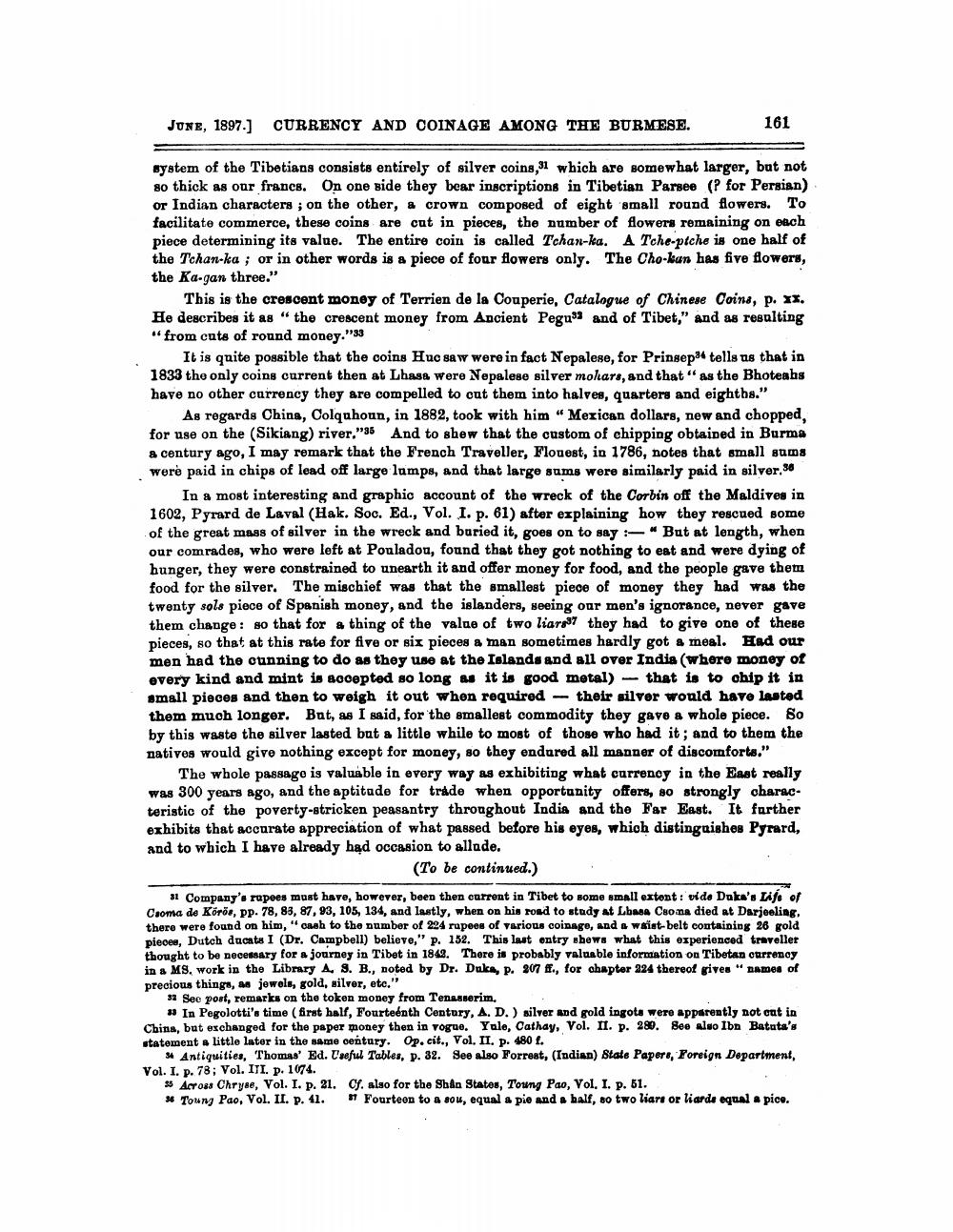________________
JUNE, 1897.] CURRENCY AND COINAGE AMONG THE BURMESE.
161
system of the Tibetians consists entirely of silver coins, 91 which are somewhat larger, but not 80 thick as our francs. On one side they bear inscriptions in Tibetian Parsee (? for Persian) or Indian characters ; on the other, a crown composed of eight small round flowers. To facilitate commerce, these coins are cut in pieces, the number of flowers remaining on each piece determining its value. The entire coin is called Tchan-ka. A Tche-ptche is one half of the Tchan-ka; or in other words is a piece of four flowers only. The Cho-kan has five flowers, the Ka-gan three."
This is the crescent money of Terrien de la Couperie, Catalogue of Chinese Coins, p. XX. He describes it as "the crescent money from Ancient Pegu" and of Tibet," and as resulting "from cuts of round money."33
It is quite possible that the coins Huc saw were in fact Nepalese, for Prinsept tells us that in 1833 the only coins current then at Lhasa were Nepalese silver molars, and that " as the Bhoteahs have no other currency they are compelled to cut them into halves, quarters and eighths."
As regards China, Colquhoun, in 1882, took with him “Merican dollars, new and chopped for use on the (Sikiang) river."96 And to shew that the custom of chipping obtained in Burma a century ago, I may remark that the French Traveller, Flouest, in 1786, notes that small sums were paid in chips of lead off large lamps, and that large sams were similarly paid in silver.36
In a most interesting and graphic account of the wreck of the Corbin off the Maldives in 1602, Pyrard de Laval (Hak. Soc. Ed., Vol. I. p. 61) after explaining how they rescued some of the great mass of silver in the wreck and buried it, goes on to say :- " But at length, when our comrades, who were left at Pouladon, found that they got nothing to eat and were dying of hunger, they were constrained to unearth it and offer money for food, and the people gave them food for the silver. The mischief was that the smallest piece of money they had was the twenty sols piece of Spanish money, and the islanders, seeing our men's ignorance, never gave them change: so that for a thing of the value of two liargs7 they had to give one of these pieces, so that at this rate for five or six pieces a man sometimes hardly got a meal. Had our men had the cunning to do as they use at the Islands and all over India (where money of every kind and mint is accepted so long as it is good metal) - that is to chip it in small pieces and then to weigh it out when required their silver would have lasted them much longer. But, as I said, for the smallest commodity they gave a whole piece. So by this waste the silver lasted but a little while to most of those who had it; and to them the natives would give nothing except for money, so they endured all manner of discomforts."
The whole passage is valuable in every way as exhibiting what currency in the East really was 300 years ago, and the aptitude for trade when opportunity offers, 80 strongly characteristic of the poverty-stricken peasantry throughout India and the Far East. It further exhibits that accurate appreciation of what passed before his eyes, which distinguishes Pyrard, and to which I have already bąd occasion to allude.
(To be continued.)
31 Company's rapees must have, however, been then current in Tibet to some small extent: vide Daka's Life of Csoma de Körös, PP. 78, 83, 87, 93, 105, 134, and lastly, when on his road to study at Lbasa Csona died at Darjeeling, there were found on him, "cash to the number of 224 rupees of various coinage, and & waist-belt containing 26 gold pieces, Dutch ducats I (Dr. Campbell) believe," p. 152. This last entry shews what this experienced traveller thought to be necessary for a journey in Tibet in 1842. There is probably valuable information on Tibetan currency in a MS, work in the Library A. 9. B., noted by Dr. Duke, p. 207 ff., for chapter 324 thereof gives " names of precious things, as jewels, gold, silver, etc."
31 Seo port, remarks on the token money from Tensseerim.
# In Pegolotti's time (first half, Fourteenth century, A. D.) silver and gold ingots were apparently not cat in China, but exchanged for the paper money then in vogue. Yule, Cathay, Vol. II. p. 280. See aluo Ibn Batata's statement a little later in the same century. Op. cit., Vol. II. p. 480 f.
34 Antiquities, Thomas' Ed. Useful Tables, p. 32. See also Forrest, (Indian) State Papers, Foreign Department, Vol. I. p. 78; Vol. III. p. 1674.
% Across Chryse, Vol. I. p. 31. Cf. also for the Shan States, Toung Pao, Vol. I. p. 51. * Tour Pao, Vol. II. p. 41. Fourteen to a sou, equal a pie and a half, so two liars or liarde equal a pice.




